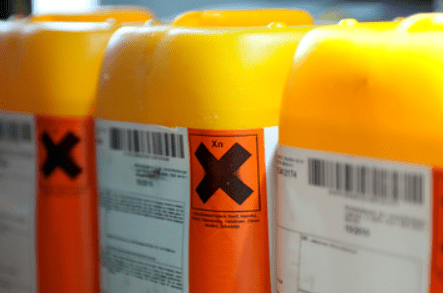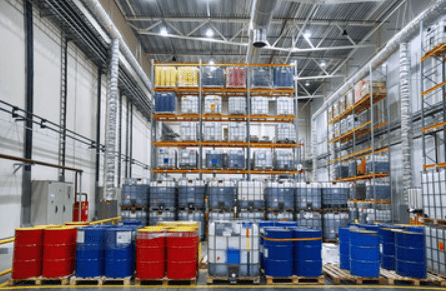Dangerous Goods: Definition, Regulations, and Classes

Companies ship various goods by land, sea, and air daily. Some are hazardous substances and pose severe effects if not handled properly.
The dangerous goods regulations and guidance are strict and enforced by various government agencies and international organizations, such as the United Nations, to minimize the risk of accidents or ensure safe transport.
Let’s look in-depth at the types of dangerous goods and some dangerous goods regulations and measures to avoid risks.
What Are Dangerous Goods?
Dangerous goods (hazardous materials) may pose a threat to human health, safety, or the environment if the goods are not stored and transported according to strict regulations.
Hazardous substances have specific characteristics that can impact others, This level of risk is the reason that there are strict regulatory requirements that must be followed when storing or transporting hazardous materials,
A hazardous material causes various risks to people, animals, and the environment. These substances can lead to the development of diseases or illnesses, environmental degradation, death, and destruction of property. There are different standards for storing and transporting dangerous goods than storing or transporting hazardous materials. It is important to understand the differences.
How Do You Identify Dangerous Goods vs. Hazardous Materials?
Dangerous goods are items specifically regulated for transportation and classified according to their hazard level. They cause an immediate impact. On the other hand, hazardous materials refer to any substance or material that may cause harm to people, property, or the environment. Hazardous materials have a long-term effect while dangerous goods pose an immediate threat.
What Are the Regulations for Dangerous Goods?
The United States Department of Transportation (DOT) requires specific documentation for transporting dangerous goods. Some of the regulations include adequately labeling hazardous materials or dangerous goods to be noted on the bill of lading when a carrier is asked to handle the shipment. Proper packaging of hazardous goods shipment in properly designed containers, labeling and marking are just a few of the regulations governing the storage or transportation of hazardous goods. Employees that work with dangerous goods must also complete special training for handling, storage, or transportation of dangerous goods. Companies are required to maintain safety regulations for any employee charged with handling hazardous goods.
What Are the 9 Classes of Dangerous Goods?

Let us look at the nine classifications of hazardous materials that help in identifying dangerous goods.
Dangerous goods classifications determine how the product should be handled, stored, or transported,
Explosives
Explosives have inherent properties that make them potentially hazardous materials when transported. They produce explosive substances that quickly release energy when subjected to certain conditions. This release of energy causes damage to property and injury or death to people.
Examples of explosives include dynamite and gunpowder used to manufacture ammunition.
In order to safely transport these materials, the product must be stored in special containers. Dangerous goods labels must be placed on vehicles that transport these products.
Employees must complete specialized training regarding handling explosives. Dangerous goods must be stored in a secure, cool area surrounded by dry ice, and away from heat sources, sparks, and flames.
Gasses
Gasses are stored under high pressure in containers and can rapidly expand if released from their containers. Some are also highly flammable and ignite quickly, posing a fire hazard.
Others are toxic or asphyxiant, causing harm to humans by affecting the respiratory system. These properties make gasses dangerous goods during transportation.
The air transport of gasses requires special precautions and equipment like dry ice to prevent their expansion. The containers used for transportation must be able to withstand the pressure of the gas and prevent leaks. Employees must also complete specialized training and licensing to ensure safe transport and handling.
Flammable Liquids
Flammable liquids have a low flashpoint, which can ignite and become flammable air and volatile chemicals at relatively low temperatures. They can rapidly vaporize in the presence of an ignition source.
The fumes generated by flammable liquids are hazardous. They spread quickly and ignite, potentially causing a fire that spreads rapidly.
These materials make them significant hazardous materials in the workplace and during transportation. Examples of flammable liquids include gasoline, lithium batteries, diesel fuel, ethanol, and paint thinner.
Handling dangerous liquids requires proper packaging, approved containers, and accurate labeling. It is important to segregate these hazardous materials from heat sources and ensure ventilation to avoid the build-up of flammable fumes.
Organizations should also install fire protection services and suppression systems in storage areas. Providers that transport these materials should ensure vehicles shipping these goods are equipped with fire protection and other applicable safety features.
Flammable Solids
Flammable solids are toxic substances that readily ignite and burn rapidly, posing a significant risk of fires. These dangerous solids have low ignition temperatures, making them subject to ignition from a spark or other ignition source.
Additionally, many flammable solids emit combustible fumes, contributing to the spread of fire and increasing the explosion risks.
It is essential to store, transport, and use flammable solids following regulations that address labeling, packaging, and safety measures to minimize the potential risks posed by these commodities.
Proper handling and storage of these hazardous materials can help prevent fires and protect people, property, and the environment. Employees must receive training about the proper handling of these dangerous goods.
Oxidizing Substances and Organic Peroxides
Oxidizing substances, such as oxygen and chlorine, can provide gasses to support combustion, making them hazardous. Additionally, organic peroxides, such as benzoyl peroxide, can be dangerous and pose risks of spontaneous combustion or detonation if not handled and transported correctly.
Both oxidizing substances and organic peroxides can release large amounts of heat during a reaction. This heat can cause fires and explosions.
Some organic peroxides are known to decompose rapidly and release gasses, making them a significant threat to human safety and the environment.
Toxic and Infectious Substances
Toxic substances are dangerous materials that require safe handling. These hazardous materials pose substantial risks to humans and the environment. They can cause death, injury, or harm to human safety if inhaled, ingested, or if they come into contact with a person’s skin. Examples of toxic goods include pesticides, hazardous chemicals, and medical products.
Infectious substances are materials contaminated with pathogenic microorganisms capable of causing human disease during transportation.
These microorganisms can spread disease and pose a significant threat to public health if not handled, packaged, and transported correctly. They include medical or clinical waste, blood, and tissues from infected animals.
In addition to proper packaging, employees must follow safety protocols and maintain a safety data sheet when working with infectious substances. Examples of these regulations include wearing personal protective equipment and practicing good hygiene.
Radioactive Material
Radioactive materials emit ionizing radiation, which is harmful to live organisms. They pose significant threats to humans and the environment if they are not properly handled, packaged, and transported.
Examples of radioactive materials include nuclear fuel, radioactive isotopes used in medical treatments and research, and radioactive waste.
It is crucial to handle radioactive materials with care, follow safety protocols, and provide employees with protective equipment to minimize the risk of exposure to ionizing radiation.
By following these guidelines and regulations, companies can reduce the chances of exposure to ionizing radiation and protect public health and the environment from dangerous materials.
Corrosive Substances
Corrosive substances are dangerous materials capable of dissolving or destroying other materials through a chemical reaction.
These substances can damage materials they come in touch with, including human skin and eyes. Examples of corrosive goods include acids, alkalis, and some chemical products.
If a corrosive substance is spilled or released during dangerous goods shipments, it damages the infrastructure, harms wildlife, and contaminates the environment. In addition, if a corrosive substance comes in touch with human skin or eyes, it can cause severe injury or blindness.
Miscellaneous Dangerous Substances
Miscellaneous substances are dangerous goods shipments that risk human health and the environment if not handled, packaged, or transported correctly.
These goods can cause fires or explosions, emit flammable gasses, or cause harm to human health if they are exposed to them in the environment without having physical contact with the substance,
Miscellaneous dangerous substances include volatile solids and spontaneous combustibles, such as lithium batteries that emit flammable gasses when placed in contact with water.
Shippers must label and package the secure storage containers of these goods. Employees should also wear protective equipment, such as gloves, eye protection, and clothing.
Dangerous Goods: Wrap-Up
The safe transportation of dangerous goods shipments is crucial to protect employees, other humans, and the environment. A comprehensive understanding of the regulations, labeling, and handling requirements is critical for companies storing or transporting these goods.
Ongoing training and updates about the latest guidelines and best practices should be a priority for organizations and individuals dealing with hazardous materials or dangerous goods. These regulations and procedures are intended to promote the safe transport of hazardous materials and dangerous goods.
